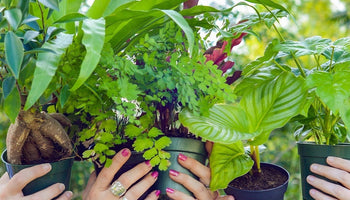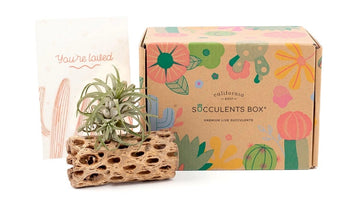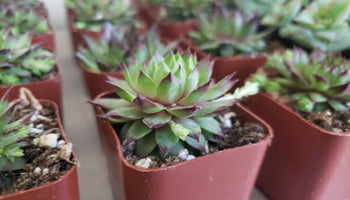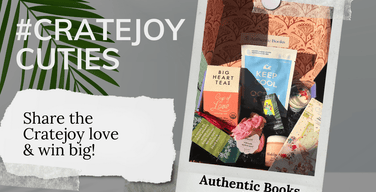How to Start a Garden at Home from Scratch
Updated by Amy Furr
Sprucing up your indoor area with house plants and succulents is a fulfilling and rewarding pastime. From the first succulent that you put in your kitchen window to the propagated pothos plants taking over your bookshelves, nothing brings plant-lovers greater joy than seeing their green babies grow. Now that the weather is warming, it’s the perfect time to translate your love of indoor gardening to the outdoors. It’s time to begin your garden.
If you’ve never started a garden before, don’t fret. With Cratejoy, you’ll find everything you need to successfully grow everything for the first time. Whether you’re getting started with a vegetable garden or flowers, growing plants and exercising your green thumb is going to be easy.
Types of Gardens
If you’re used to cultivating succulents inside your home, you might be surprised to learn that there are many different types of gardens outside. Depending on what you’re looking to accomplish in your soil, you’ll want to start with a small garden by planting a variety of plants.
For example, your garden could be filled to the brim with herbs that you can use in your kitchen. Or you could plant a vegetable garden to grow your own cucumbers and beets. Growing your own food by vegetable gardening at home helps you save money throughout the year and gives you a whole lot of satisfaction.
Of course, there are also flower gardens. Plant a rose bush, get tulips fit for your vase, or even challenge yourself to grow an outdoor orchid garden. Consider first what you want to get out of your garden—besides green thumb satisfaction —and then move forward with your goals in mind.

Cratejoy Gardening Tip
Starting with flowers common to your area can make gardening much easier on yourself. Mix and match by planting some local flora and a few more challenging plants! That way, you’ll feel accomplished no matter what happens to your plant babes.
Raised Beds Or Garden Boxes For Small Gardens
Once you’ve narrowed down what type of garden you want to plant—don’t forget, there’s no wrong answer—it’s time to get started! First, research your plants and make sure that you’re planting at an optimal time for your growing season —each area of the world has a different hardiness zone and frost dates, both of which will impact how your plants grow.
If you’re planning on growing an herb garden or small flowers like pansies, order a raised bed. These are great for anything that doesn’t need a very deep root because a raised bed limits how deep the roots can grow. They will also have minimal impact on your backyard landscaping which is ideal for new gardeners who are experimenting with their outdoor green thumbs.

If you’re leaning towards a variety of plants, veggies, and flowers, you should order (or DIY!) your garden beds to get started. Then, it’s time to prepare the compost, mulch, and soil.
Why You Should Compost For Your Plants
Sure, it’s easy to pick up bags of garden soil from the garden center at a home improvement store or nursery. But when you’re upping your green thumb from succulents and houseplants to an outdoor garden, you’ve got to make sure you use the very best soil. The very best soil is organic matter compost.
Sometimes referred to as “black gold,” compost is full of the nutrients that your outdoor plants crave. Ensure you’re giving your plants the very best, you should feed them regularly with compost. When plants are given compost, the results are better tasting vegetables and stronger plants.
How to Compost
Because composting is becoming much more popular it’s easier than ever to get started. First, choose whether you want to use a compost bin or keep your compost in an open pile. Bins are easier to maintain, they stay hotter (which helps break down the scraps), and they keep animals out.

When you’re ready with your composting location, start by layering organic materials. Add some twigs and leaves to the very bottom to make sure that your compost is aerated, then stack “greens” and “browns.” Greens refer to organic nitrogen-rich material and browns refer to carbon-rich material. In other words, greens are other plants and browns are things like dried leaves, cardboard pizza boxes, and even laundry lint. A good mixture of both is important to get the best dirt for your garden.
After your compost is layered, you can—and should—add to it often. Rotate it regularly and only use the nutrient rich soil inside when it’s finished decomposing. While your compost is processing, it’s time to order your plants.
Acquiring Your Garden Plants
If you’re ordering a plant subscription box from Cratejoy, you’ll have a head start on this part. Most of the garden subscription boxes include everything you need to get started with seeds to germinate your own plants. Follow the instructions on your seed subscription to ensure that your plants will grow and be happy.

Cratejoy has plant subscriptions for every type of garden —seriously. From seed packets to seedlings, all you’ll need to do is pick up the trellis and topsoil.
Cratejoy Gardening Tip
If you’re having trouble choosing the perfect monthly plant subscription, check out this guide that will help you narrow down your options.
Creating Your Garden Plan
For new gardeners who aren’t as familiar with outdoor gardening, knowing where to plant each of your plants can feel intimidating. It’s not as simple as buying a pot and finding a spot on your bookshelf. Or is it?
Once your garden beds are built and filled with mulch, it’s time to start planning where to put each of your seedlings. Eventually, you’ll have the know how to do this in your sleep. For new gardeners, this is a mixture of art and science. Especially if you’re working in a container garden or only have space for a small garden in your backyard.

Start by figuring out which of your plants will need full sun and which ones want some afternoon shade. You can still place them in the same bed, just be prepared to hang some shade panels over your young plants that don’t need full sun. Once you’re familiar with the sun requirements of each plant, you’re ready to start spacing them out.
Plant Spacing
This is where the art of gardening comes in—your garden design. Grab a piece of paper and a pencil (or pen, if you’re feeling confident!) and draw out your garden plan. Be sure to factor in spacing so that each of your plants has room to grow.
To keep all of your plants happy, place your short plants on the edge of your garden bed so that they get plenty of sunlight. This will also help maintain your access to all of your plants and areas of your garden to get rid of any pesky weeds. Once your garden plan is complete, it’s planting time.
The Final Step: Planting Time
Using a mixture of mulch, compost, and native dirt will give your plants the best chance of success, so be sure to fill your garden area with a solid mixture of the three. Then, top it off with topsoil which will help your plants retain water and avoid eroding your precious mulch mixture. With your garden plan in hand it’s time to get your seeds into the ground. Soon, you’ll be growing plants.

Treat your garden plan like a map and create your plant grid so that you can easily track which plant is which as they grow. Once your grid is laid out, pop your seeds about three inches under the dirt. Water all of your seeds and then watch them grow.
Enjoy The Fruits Of Your Labor
After months of watering, weeding, and tending to the plants in your backyard you can now kick back and enjoy the fruits of your labor—literally! Pick your tomatoes, dice up your radishes, or stop and smell the flowers you’ve planted with Cratejoy. Keep in mind which plants were your favorites for next year!
Then, start all over again with your next garden subscription box . You’ve earned it.














